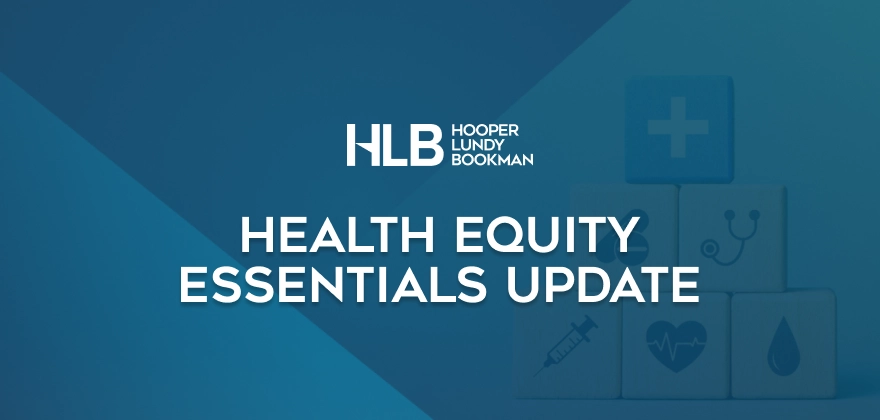
On behalf of the Hooper, Lundy & Bookman, P.C. Health Equity Task Force, here is our most recent HLB Health Equity Essentials Update.
MANY RURAL HOSPITALS CLOSE IN THE FACE OF MOUNTING FINANCIAL PRESSURES
The Center for Healthcare Payment & Quality Reform (CHPQR) reports that over 100 rural hospitals have closed during the past 10 years. Rural hospitals in the Midwest and southern states are particularly at risk of immediate closure. The end result is that millions of people living in rural areas will be without access to more specialized inpatient and outpatient care. And it is not just the patients themselves who are impacted; family members will have to travel up to two hours to visit or accompany them to appointments. Myriad reasons contribute to these hospitals’ financial challenges, including trouble recruiting and retaining sufficient qualified staff for certain service lines; ceasing to receive extra federal assistance that was available during the COVID pandemic; receiving insufficient payor reimbursement to cover the larger overhead costs experienced by rural hospitals; and lacking sufficient financial reserves to ride out economic downturns.
CMS UNVEILS MODIFIED POLICIES AND INCREASED REIMBURSEMENTS FOR HOSPITAL INPATIENT AND LONG TERM CARE HOSPITAL (LTCH) SERVICE
The Centers for Medicare and Medicaid Services (CMS), through its FY 2025 Hospital Inpatient Prospective Payment System (IPPS) and Long-Term Care Hospital Prospective Payment System (LTCH PPS) Final Rule, issued policies aimed at furthering the Biden Administration’s goal to improve the health of communities historically underserved and lacking vital resources, as well as incentivizing value based care. By employing social determinants of health (SDOH) in making policy-related decisions, CMS is able to fine tune its allocation of resources to target those individuals most in need of improved access to equitably delivered care. One such development includes enhanced reimbursement for hospitals treating patients facing housing insecurity. Another CMS measure is to extend a separate payment to small independent hospitals–many of which are rural–that establish and maintain access to a buffer stock of essential medicines, thereby helping to lessen the risk of drug shortages and improve patient care. In addition, both LTCHs and certain qualifying general acute care hospitals will receive broad reimbursement hikes under their respective prospective payment systems.
CMS FURTHERS EFFORTS TO IMPROVE HEALTH INEQUITIES IN ITS PROPOSED 2025 HOSPITAL OUTPATIENT AND AMBULATORY SURGICAL CENTER (ASC) REIMBURSEMENT RATES
CMS’s proposed annual hospital outpatient and ASC reimbursement rate schedule was published in July. This year’s proposed rule includes initiatives to address disparities in care. Among the proposals are requiring 12 months of continuous eligibility for children enrolled in Medicaid/CHIP; expanding the hospital outpatient, rural emergency hospital, and ASC quality program measure sets to incorporate equity measures consistent with other provider types; and providing an add-on payment to the All-Inclusive Rate for certain Indian Health Service (IHS)/tribal facilities that will increase access to certain high-cost drugs; and supporting individuals returning to the community from incarceration through the elimination of Medicare enrollment barriers.
COVID 19 PANDEMIC WORSENED THE DISPROPORTIONATE IMPACT OF THE NATION’S DIRE MENTAL HEALTH CRISIS ON NON-WHITES
New University of Southern California (USC) School of Medicine and Los Angeles County Department of Public Health joint research indicates, unsurprisingly, that areas of LA County with the highest reported COVID case rates also experience a corresponding higher incidence of depression. By some accounts, just as unsurprising was data indicating that in areas more afflicted with COVID, non-Whites incurred an increased risk of depression compared to Whites residing in those same locations.
LATEST MEDI-CAL ECM AND COMMUNITY SUPPORTS QUARTERLY IMPLEMENTATION REPORT SHOWS PROMISING RESULTS
In 2022, California announced its plans to revamp the Medi-Cal program into one that would be more equitable, focused on the individual and improved coordination among available providers and services. The two hallmarks of the effort are the Enhanced Care Management (ECM) and Community Supports programs. Earlier this year, ECM was expanded to include “justice-involved” individuals and Medi-Cal launched the ECM Birth Equity Population of Focus (POF). As of 2024, every county in the state will have at least 8 Medi-Cal managed care program (MCP) sponsored Community Supports at their disposal and 19 counties will have all 14 Community Supports, in both instances a notable increase from 2023. Click here to view the report.
CLICK BELOW FOR MORE HLB HEALTH EQUITY UPDATES:
Health Equity BlogProfessional
If you have any questions, please reach out to Alicia Macklin, Sandi Krul, Monica Massaro, Kerry Sakimoto, or your regular HLB contact.



